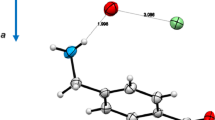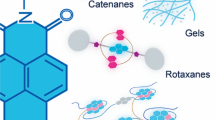Abstract
Two 3D supramolecular architectures, [Cu(tmbdc)(NH3)2] n , 1, (tmbdc = 2,3,5,6-tetramethylbenzenedicarboxylate), and {[Cu3(btc)2(NH3)6(H2O)]·2H2O} n , 2, (btc = 1,3,5-benzenetricarboxylate) have been assembled with 1D or 2D coordination polymers as supramolecular synthons. The geometry matching of the moieties is the key factor for the formation of the two supramolecular architectures by the cooperation of coordination bonds, hydrogen bonds and π···π interactions. Crystal data for 1: Formula CuC12H18N2O4, monoclinic, space group P21/c, a = 9.0134(5), b = 10.8785(5), c = 6.4702(3) Å, β = 91.679(1)°, V = 634.15(5) Å3, Z = 2, R 1 = 0.0251 and wR 2 = 0.0722. Crystal data for 2: Formula Cu3C18H30N6O15, monoclinic, space group C2/c, a = 13.9213(5), b = 17.1210(6), c = 12.5271(5) Å, β = 114.779(1)°, V = 2710.89(17) Å3, Z = 4, R 1 = 0.0245 and wR 2 = 0.0665. The positions and isotropic displacement parameters of all the hydrogen atoms are refined.
Graphical Abstract
The geometry matching of the moieties of 1D or 2D coordination polymers leads to the formation of two 3D supramolecular architectures by the cooperation of coordination bonds, hydrogen bonds and π⋯π interactions.







Similar content being viewed by others
References
Desuraju GR (1995) Ange Chem Int Ed 34:2311–2327
Steiner T (2002) Ange Chem Int Ed 41:48–76
Meyer EA, Castellano RK, Diederich F (2003) Ange Chem Int Ed 42:1210–1250
Brammer L (2004) Chem Soc Rev 33:476–489
Burrows AD (2004) Struct Bond 108:55–95
Brammer L (2003) Dalton Trans. 3145-3157
Beatty AM (2003) Coord Chem Rev 246:131–143
Roesky HW, Andruh M (2003) Coord Chem Rev 236:91–119
Janiak C (2000) J Chem Soc, Dalton Trans. 3885–3896
Guilera G, Steed JW (1999) Chem Commun. 1563–1564
MacDonald JC, Dorrestein PC, Pilley MM, Foote MM, Lundburg JL, Henning RW, Schultz AJ, Manson JL (2000) J Am Chem Soc 122:11692–11702
Batten SR, Hoskins BF, Moubaraki B, Murray KS, Robson R (2001) CrystEngComm 8:1–3
Applegarth L, Goeta AE, Steed JW (2005) Chem Commun. 2405–2406
Heinze K, Reinhart A (2006) Inorg Chem 45:2695–2703
Du M, Zhang ZH, Zhao XJ (2005) Cryst Growth Des 5:1199–1208
Zou R-Q, Liu C-S, Shi X-S, Bu X-H, Ribas J (2005) CrystEngComm 7:722–727
Burrows AD, Harrington RW, Mahon MF, Teat SJ (2005) CrystEngComm 7:388–397
Paul B, Zimmermann B, Fromm KM, Janiak C, Anorg Z (2004) Allg Chem 630:1650–1654
Ko JW, Min KS, Suh MP (2002) Inorg Chem 41:2151–2157
Wang X-L, Lin H-Y, Hu T-L, Tian J-L, Bu X-H (2006) J Mol Struct 798:34–39
Bu XH, Tong ML, Li JR, Chang HC, Li JL, Kitagawa S (2005) CrystEngComm 7:411–416
Yang SY, Long LS, Huang RB, Zheng LS, Ng SW (2005) Inorg Chim Acta 358:1882–1886
Yang SY, Long LS, Wu ZY, Zhan MX, Huang RB, Zheng LS (2002) Transition Met Chem 27:546–549
Acknowledgments
We are grateful for the financial support of the National Natural Science Foundation of China (Grant No. 20471049, 20721001) National Basic Research Program of China (973 Program) 2007CB815301, NFFTBS (No. J0630429) and Xiamen University.
Author information
Authors and Affiliations
Corresponding author
Rights and permissions
About this article
Cite this article
Xu, XB., Lan, FF., Yang, SY. et al. Two 3D Supramolecular Architectures Assembled With 1D or 2D Coordination Polymers by Cooperation of Coordination Bonds, Hydrogen Bonds and π···π Interactions. J Chem Crystallogr 40, 551–556 (2010). https://doi.org/10.1007/s10870-010-9695-9
Received:
Accepted:
Published:
Issue Date:
DOI: https://doi.org/10.1007/s10870-010-9695-9




